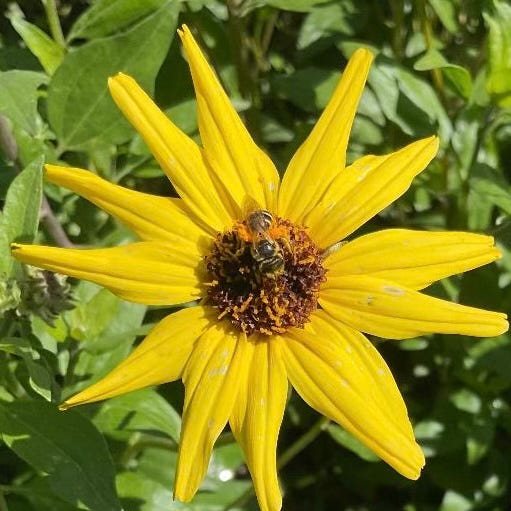Coastal sage scrub, drought, and invasive species
Climate-driven drought could further jeopardize this endangered biome
My garden is an extravaganza of blooms. While the shine has come off the California sunflowers, the San Diego sunflowers are still showing off their brilliant yellow. The monkeyflower plants are loaded with creamy blossoms; the bladderpod shrubs are in full bloom; and the matillija poppies are going ca-ray-zee!!!
My pollinator garden comprises plants of coastal sage scrub, a plant community that is underappreciated and often overlooked. It tends to get grouped with chaparral, especially by folks who don’t spend much time in Southern California. But this plant community is distinct, and if you spend enough time on the trails you learn to readily distinguish it from chapparal.
Briefly, chaparral plants are woody, evergreen, and grow taller than the shrubs of the coastal sage. Many coastal sage plants are deciduous, dropping their leaves during the six months of summer drought. If you’ve been in Southern California and gotten a good whiff of sage on a trail, you’ve been in the coastal sage scrub plant community.
With urban sprawl, we’ve paved over a lot of coastal sage scrub. It also seems that we take every opportunity possible to turn perfectly good coastal sage habitat into just about anything that doesn’t resemble Southern California. We have large expanses of grass, like what you see in Kentucky or Ohio. We’ve planted eucalypti from Australia, showy flora from the Pacific Islands, and even fynbos from South Africa. All in all, it’s probable that we have destroyed more than 80 percent of the coastal sage scrub habitat.
Drought in Southern California and the rest of the Southwest is common and can last for multiple years. Coastal sage scrub is adapted to this variability, thriving in wet years and receding in dry. Gardening and working with native plants, as I’ve done for the last 15 or 16 years, I’ve seen how plants can grow super-lush when we get a lot of rain. I’ve also seen the same plants pull back during dry spells. We’ve had some long-term drought in the last two decades, and during those times, plants such as the bladderpod in my garden remained almost leafless, even when there was some rain, and some of their branches died.
This plant community is also naturally adapted to recurring fire. Some species resprout from underground burls post-fire; other species need the heat or smoke from a fire to germinate. The natural sources of fire ignition, thunderstorms, have been a rarity for the coastal environments of Southern California. Naturally occurring fires are hence historically rare for the coastal sage scrub biome. For at least 20 years, scientists have noted that an increase in fires in Southern California—from our tossed cigarettes, sparks from power lines, and firebrands from our barbecues—decreases the native flora and opens the landscape to invasive species, especially nonnative grasses.

Climate projections for the state indicate more extreme weather, with more storms possibly bringing more rainfall; at the same time, droughts will become more severe, with the number of dry years increasing. Though coastal sage plants are adapted to droughts, new research indicates that climate-driven droughts can worsen the situation for the coastal sage, leaving them more vulnerable to invasion from nonnative plants.
The new research
Scientists from the University of California, Irvine, looked at plots of coastal sage in the Loma Ridge Global Change Experiment (LRGCE), a research area comprising 6.5 hectares of coastal sage and grasslands in the foothills of the Santa Ana Mountains. On an ongoing basis, for research purposes, water regimes in different sites of the LRGCE are manipulated. Some sites are left alone to get natural watering from rainfall, while others receive reduced watering (simulating drought), and some receive additional watering.
In 2020 the Silverado Fire burned the LRGCE, giving researchers an opportunity to compare the fire recovery of the of coastal sage in drought and non-drought conditions. After the fire, the areas under long-term drought conditions had more nonnative grasses than the other plots.
The researchers explain, under normal conditions, when coastal sage burns, the fires consume all the brush and burn hot. Seeds of the native coastal sage survive these high-severity fires, while the seeds of nonnative grasses are killed off. During long-term drought, coastal sage plants are dwarfed, growing smaller. The smaller plants provide less fuel, so when there is a fire it doesn’t generate the same amount of heat as under normal conditions. So droughts reducing the fuel load of a coastal sage environment Ultimately open up opportunities for nonnative grasses to survive fires and outcompete the native plants.
Lots of news about climate change is scary or upsetting. Reading about this new threat to coastal sage has me more bummed than usual. As you can tell, I’ve grown to love the natural landscapes of Southern California, and I hate to see them further threatened. How about you? Is climate change threatening the natural landscape where you live. Please click the “Leave a comment” button.




Thanks for the interesting write up on a landscape I’ve come to enjoy as a visitor through our family’s annual winter pilgrimage to the California coast. As a native New Englander, we’ve been watching the salt marshes attempt to keep up with rising sea levels. There’s a certain amount the spartina grasses can keep up with, but they’re typically hemmed in by development from advancing inland. Check out the Trustees of Reservations work with the Great Marsh if you’d like to learn more about this unique ecosystem. https://www.onthecoast.thetrustees.org/great-salt-marsh-restoration
Great article, Paul. One of my favorite biomes and my area of expertise when I lived in southern California and worked at Tucker Wildlife Sanctuary and RSABG. Coastal properties are much sought after by the wealthy for giant houses with exotic plants and acres of lawn. Our scrubby little plants are so adaptable but can’t compete with the bulldozer. Heatbreaking.